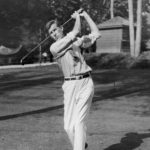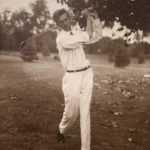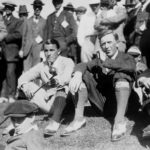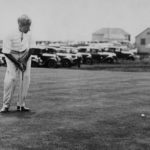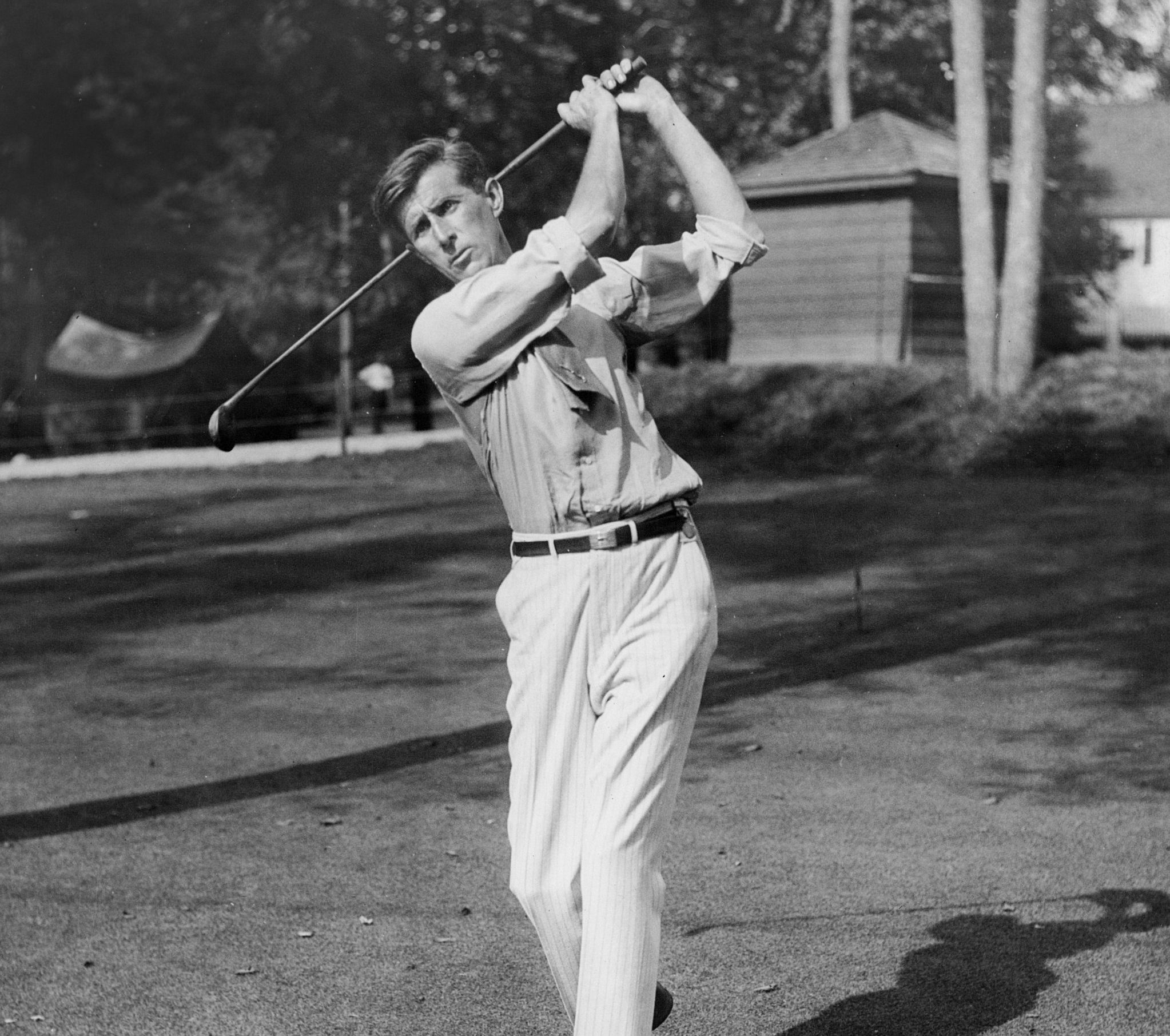
Jim Barnes (2023)
About Jim Barnes (2023)
In January 1924, when “Long” Jim Barnes announced he was resigning as the golf professional of Pelham Country Club just north of New York City to play in tournaments and exhibitions full time, the news hardly went unnoticed. The New York Times ran a story the next day, under a string of subheadings proclaiming:
“Severs Connection with Golf Club and Will Leave for South in Near Future”
“No Successor Yet Named”
The attention Barnes’s departure received testifies to the stature he held not just in the Met Area but throughout the world of golf. Since immigrating to the United States at age 20 in 1906, the tall, lanky Englishman with chiseled features and a powerful swing helped lead a generation of British and Irish pros in establishing the game’s roots on American soil.
Barnes stood 6 feet 4, “as lean as Chile, with a thatch of undisciplined light-brown hair swirling above his studious face,” in the words of Herbert Warren Wind. The nickname “Long Jim” referred both to his height and the length of his drives.
By 1924, Barnes had won three major titles (by today’s definition): two PGA Championships and a U.S. Open. Prior to coming to the Met Area, he served as a club professional in Oakland, Calif., and across the Pacific Northwest. He later moved to the Broadmoor Club in Colorado and to points east, including St. Louis and Philadelphia.
In the storied 1913 U.S. Open at The Country Club in Brookline, Mass., Barnes finished in a tie for fourth behind the unlikely winner, 20-year-old amateur Francis Ouimet, and the two English legends he beat in a playoff, Harry Vardon and Ted Ray.
The following year, Barnes won the first of three Western Opens, and in early 1916 captured the North and South Open at Pinehurst, which he would win again in 1919. Both tournaments were widely considered majors at the time.
But it was at the 1916 PGA Championship at Siwanoy Country Club in Bronxville, N.Y., the inaugural playing of the event, that Barnes solidified his renown. The PGA had a match-play format back then, and Barnes defeated one of his rivals, Scotsman Jock Hutchison, 1-up, in the 36-hole final to claim the Wanamaker Trophy. Barnes, Hutchison, and Walter Hagen, who pioneered the career of golf professional among Americans – amateur golf had been seen as a higher, more gentlemanly calling – formed a triumvirate of dominant players into the Roaring Twenties.
“All that Barnes needs to win a golf tournament is a golf course, a putter, and a liberal supply of the clover leaves that he carries in the corner of his mouth,” the Times enthused, referring to one of his trademarks in popular lore.
The second PGA Championship was played at Engineers Country Club in Roslyn, N.Y., in 1919 after a two-year hiatus during World War I, and once again Barnes prevailed. He beat Fred McLeod, another prominent Scottish pro, 6 and 5 in the finals.
His next major triumph came in the 1921 U.S. Open at Columbia Country Club in Chevy Chase, Md., one week after Barnes had opened the new 18-hole course at Pelham. Barnes’s winning score of 289 placed him nine strokes ahead of his nearest pursuers, Hagen and McLeod. To this day, it stands as the championship’s third-widest margin of victory.
The impressiveness of Barnes’s feat wasn’t lost on President Warren G. Harding, who along with Vice President Calvin Coolidge, attended the tournament each day. Harding, a golfer himself, praised Barnes as representing “the best in a noble and becoming sport.”
In 1925, Barnes captured his fourth and final major title, the Open Championship, at Prestwick. Teeing off early the final day, he stormed from behind to surpass the 54-hole leader, Scotland’s MacDonald Smith, and win by one on a day marked by unruly crowds who overwhelmed the hemmed-in historic links. Prestwick would never host the Open again.
Barnes received an invitation to compete in the first Masters in 1934, but he was two weeks shy of turning 48 and declined to play. He is one of only three British golfers, along with Tommy Armour and Rory McIlroy, to have won three of golf’s four major championships.
Barnes’s legacy also includes writing two early instructional books, Picture Analysis of Golf Strokes (1919) and A Guide to Good Golf (1925). In the latter, he focuses largely on the mental side of the game, urging readers to visualize an effective swing and follow it instinctively, lamenting that many a golfer instead “makes labor of what should be a light task.”
His departure from Pelham in 1924 marked the beginning of only an interim period away from the Met Area. He later returned to work at a number of clubs in the region, including the now-defunct Rockwood Hall in Tarrytown, N.Y.; Essex County Country Club in West Orange, N.J.; and, his final official post, at North Hempstead Country Club in Port Washington, N.Y.
Barnes’s slightly looping, crouching swing held up years after his prime. In 1939, at age 53, he won the New Jersey Open, becoming the oldest champion of the event. When he died at 80 in East Orange, N.J., a headline aptly described him as a “Giant in His Day.” – Paul Rogers
Connection to MGA. . .
Jim Barnes served as a professional at several MGA clubs throughout his career and life. Barnes was the professional at Pelham Country Club until 1924 when he resigned to play in tournaments full time. He would later return and hold positions at several clubs in the region, including the now-defunct Rockwood Hall club, Essex County Country Club and North Hempstead Country Club. In addition, Barnes won the 1916 PGA Championship at Siwanoy Country Club in Bronxville.
NOTEWORTHY STATISTICS ABOUT MET AREA COURSES
Winner
1919 PGA Championship – Engineers
Winner
1916 PGA Championship – Siwanoy
Winner
1937 Long Island Open
ADDITIONAL DETAILS & MULTIMEDIA
Life Events
- Date of Birth: April 8, 1886
- Date of Death: May 24, 1886 (80)
- Hometown: Cornwall, England
- Club Affiliation: Pelham Country Club, Rockwood Hall, Essex County Country Club, North Hempstead Country Club.
Achievements
- 29 total professional wins, 22 PGA Tour wins, 4 Major wins (2 PGA Championships, 1 U.S. Open, 1 Open Championship)
- He is one of only three British golfers, along with Tommy Armour and Rory McIlroy, to have won three of golf’s four major championships.
- 4x PGA Tour Player of the Year (1948,1950,1951,1953)
- Inaugural member of the PGA Hall of Fame 1940
- World Golf Hall of Fame, Class of 1989

